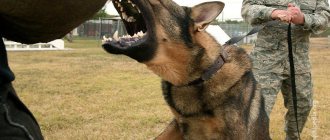Unreasonable barking is a serious problem, but conscious barking is a source of pride for your pet. The ability to bark at a specific signal is included in the standards of training courses for service dogs, but can be useful even for decorative breeds.
To quickly master the skill, it is recommended to enroll in the nearest kennel club. There they will explain to you in detail how to teach your dog the “Voice” command. Self-study uses similar methods, but requires more time and persistence.
Preparing for training
Before starting training, you need to determine your pet’s psychotype and find a quiet place for the first training. Dog trainers recommend spending 40-60 minutes a day 2-3 times a week on exercise, so another important point is having free time.
Determination of an animal's psychotype
The classification of people and animals according to psychotypes is similar. In both cases, temperament is divided into 4 types:
- Sanguine
. For dogs from this group, the “Voice” command is one of the simplest. Such four-legged animals can be trained without outside help. They know how to restrain unnecessary emotions that distract from classes, and are active enough to master new skills.
- Choleric
. Choleric dogs are eternal puppies. They are open to new knowledge at any age and are extremely attached to their owners. Their only drawback is excessive emotionality, which makes it difficult to concentrate on doing the exercises.
- Phlegmatic
. Phlegmatic people do not tolerate the monotony of learning and always think about their decisions. The training of such pets should exclude frequent repetition of already learned skills. The reward system is no less important. The best reward is the praise of a beloved owner, but food reinforcement almost doesn’t work here.
- Melancholic
. Melancholic animals are the most difficult to train. Such four-legged animals are passive, timid and prone to withdrawal. For this reason, they require more time and care to learn new skills.
Please note: Some breeds are naturally silent. Akita Inu bark solely at will, and Basenjis do not even know how to reproduce the “woof” we are used to.
What you need from the owner
In addition to free time, patience and desire, you will need incentive tools. At the very beginning, it is better to use treats and toys for this. A leash will come in handy as ammunition. There is no need for special equipment, which greatly facilitates the training process.
Choosing a training location
The first classes should be carried out at home to eliminate discomfort from extraneous irritants. As soon as the dog feels confident, go outside. Hone your workouts in different places, from an enclosed courtyard to a busy street.
Practical advice from experts
- The training methods outlined are suitable not only for puppies, but also for adult dogs. If you show restraint, your pet will soon thank you with his newly acquired skill.
- Study your pet, determine what most often causes him to bark. Use the acquired knowledge during the training process.
- The “Voice” exercise can be repeated several times a day , gradually honing the skill.
- Once your dog has fully internalized the command, you can move from rewarding with treats to rewarding with exclamations and petting.
- If your dog obeys commands hesitantly and fearfully, you may have been too strict with him. To improve the situation, reward your pet generously after completing the next command. It is very important for your four-legged friend to get the owner's approval.
- One person can train a dog, however, each family member should be able to get it to follow directions.
- If the dog responds correctly to the “Voice” command, while being in any position at a distance of 10-15 meters from the owner, you have achieved the desired result.
- Sometimes a dog's barking is inappropriate and can anger household members, so it is important to teach your pet not only the “Voice” command, but also the “Quiet” command in order to stop the noise on demand.
Labradors are easy to train, but it is important to start on time. A detailed description of the Labrador breed is on our website.
The Cane Corso is a prestigious dog and we can safely say that the popularity of the breed will only grow. Find out more here.
Whatever methods you use to train your dog, the main thing is to remember that you are communicating with an intelligent living being. Your pet will happily carry out all the required commands if your relationship with him is built on mutual respect and supported by devotion. Do not disappoint your four-legged friend, because for him you are an undisputed leader and an unchanging ideal.
Training methods
Methods explaining how to teach a dog to the “Voice” command differ from each other in the source of excitement. This facilitates an individual approach to the four-legged animal.
Interest
This method is based on interest in food or a toy. Let your pet sniff the treat or tease him with a squeaky ball. Having aroused interest, move the object to the side so that the dog cannot reach it. Particularly active four-legged animals may require a leash for a more secure hold.
Unable to grab what he wants, the dog will definitely start barking. At this moment, command “Voice”, praise him and give the demonstrated object.
Imitation
Puppies often copy the behavior of adults, and this is often used during training. The imitation method involves training together with an experienced four-legged animal, so you can’t do it without the help of a friend.
The relationship between demonstrating a skill and subsequent reinforcement during a shared walk is quickly imprinted in the kids’ minds. As soon as the puppy masters a new trick, give him a treat and praise him.
Eavesdropping
The simplest method suitable for any psychotype. Here you need to wait for a bark for any reason, say the command word and give out an award.
Please note that only desired barking should be rewarded with treats. In all other cases, the pet will have to be ignored. Thanks to this, he will bark only when commanded.
Irritation or defensiveness
This method of training is not suitable for melancholic people, since any stress is harmful to their delicate nervous system. The source of excitement here is irritation at unwanted or painful actions, as well as the defense of the object from the attack of an attacker. Service dogs are trained according to this scheme.
Gesture
Barking with a gesture requires more concentration. It is recommended to master it when the dog remembers the voice signal.
To achieve the correct pose, bend one of your arms at the elbow so that your forearm is at chest level and your hand is at shoulder level. The inner side of the palm should be turned towards the pet, pressing the thumb against it. When giving an order, swing your palm from right to left, avoiding tilting it forward or backward.
Desire to go for a walk
Prepare your walking gear and show it to your pet. After that, head to the exit in splendid isolation. This action is likely to provoke barking, so all you have to do is say the command word in a timely manner, praise your excited pet and take him outside as a reward.
Where to train
- For quality training, in order for the dog to be controllable in any situation, classes must be carried out in various environments. The more places classes are held, the higher the chances of your pet being obedient in stressful situations and with a large number of distractions.
- But the first training should be carried out in a quiet place where nothing will disturb the puppy, so that he gets used to concentrating on his owner. You can start practicing at home, gradually making it more difficult to practice in new places, first quiet, and then with irritants.
What's the best way to encourage your pet?
Proper motivation speeds up the training process, so pay special attention to it. When choosing rewards, use an individual approach, based on the characteristics of your pet.
Delicacy
The “Voice” command for a treat is best suited for dogs in the active growth phase. During this period, animals constantly want to eat, so food is the best stimulant for them. Missed feeding increases the effectiveness of training.
Game or walk
You can interest puppies, representatives of hunting breeds and other active dogs with this toy. The same is true for walking.
If your pet is inactive, then it is better to resort to reinforcement with a treat. This method of reward works on most animals.
Perfecting the “Voice” command
When the dog masters the command well, start further polishing the skill.
The first thing to start with is to get your pet to bark at your first command. In the initial stages, it was acceptable to repeat “Voice, voice” many times, but later on, say “Voice” exactly once and patiently wait for it to happen.
Also, stop rewarding your dog if it barks without your command. By rewarding her for this behavior, you will train her to bark uncontrollably. If she periodically wants to bark, and you don’t mind, then let her bark. But keep in mind that if you are often against barking, scolding or punishing it, then the dog may stop following the “Voice” command altogether. Therefore, try to maintain a golden mean.
Helpful information
It will be useful for those who are training a pet on their own for the first time.
Who will need this command and when?
In order to somehow teach a dog the “Voice” command, you need to become familiar with the main purpose of this skill. It is most often used when working with service breeds. This group includes the following varieties:
- shepherds;
- security and sentry;
- search and rescue;
- hunting;
- wanted;
- guides.
With the help of barking, these animals scare away potential intruders, protect objects entrusted to them, notify about a sudden deterioration in the health of their owner, the appearance of prey, as well as the presence of prohibited substances, criminals or people injured under the rubble.
“
For all other pets, this skill is less important, but still useful. Small dogs are often notorious for barking, so conscious barking is an effective way to control their vocal behavior.
At what age is it optimal to learn a command?
The age of the quadruped directly affects the speed of learning. The younger the dog, the easier it is to train him. As they get older, concentration and motivation weaken, so older animals take longer than puppies.
Puppy training
Dog trainers recommend taking your time and not looking for information on how to teach a puppy the “Voice” command until the puppy is 2-4 months old. First of all, the baby must remember his nickname, place to sleep and toilet.
How many times should a dog bark
Once your pet has mastered the basics, decide how many times he should bark on the “Voice” command - one, three or more times. Teaching a dog to bark exactly five or exactly seven times will be difficult since most dogs can only count to three. With larger numbers, they often get confused and simply bark for a long time.
If you are learning a command for fun, you can teach your dog to vocalize once or bark as much as he wants. Three barks are usually taught to hunting dogs and search and rescue animals.
- To teach your dog to vocalize once, do the following: command “Voice” and immediately after the first “woof” give him a treat. If she continues to bark after swallowing the treat, gently pinch her muzzle with your hand.
We pinch the muzzle so that the dog vocalizes only the required number of times.
- To teach a dog to bark three times , do the same - say “Voice”, wait until the dog barks three times and give it a treat. If she continues to bark after this, gently pinch her muzzle. If the dog only barks once on command, continue repeating “Voice,” “Voice.” When your dog barks three times, reward him.
Practice the exercise several times to consolidate the result.
Stranger!
Execution of this command is a manifestation of aggression by the dog towards a specific person, but without attacking him. Training should be carried out under the guidance of a canine handler and with the participation of a person unfamiliar to the shepherd who will cause aggression.
Remember that raising a dog comes first, and only then such serious skills as this.
You can teach the “alien” command like this:
- the dog is near the owner;
- the person involved is passing by, he can wave his arms, make small lunges towards the owner, talk loudly;
- the owner pronounces “stranger” in a quiet but clear voice;
- as soon as the shepherd dog begins to bark, growl and prepare to attack, the person involved leaves, and the pet is encouraged with praise.
Important ! It is worth practicing “stranger” with dogs that have reached the age of one and a half years, when the psyche is fully formed.
Guidance
Focused work
The handler is playing a prank on the dog. At the most interesting place, the toy ends up in the hands of the conductor in such a way that the four-legged student cannot reach it. The teacher begins to tease the pet, but does not give the toy back. As soon as the dog barks, it is immediately rewarded with a toy.
When teaching using the pointing method, it is very convenient to hold the toy above your own head. The dog stands in front of the handler; if it starts jumping, instead of giving a voice, it does not receive encouragement.
Several times the pet is reinforced without a prior command. When the animal understands that it is receiving a reward for barking, the “voice” command is introduced.
Where to begin?
Training begins away from noisy city streets
The first thing you need is to choose a quiet place, without unnecessary external stimuli. Learning to bark at home is an activity that causes discontent among neighbors in an apartment building. And the owner himself will feel uncomfortable living with a pet that constantly barks in the apartment.
So, the choice of location comes first. This is followed by the dog's favorite toy and plenty of treats. The conductor's further actions depend on the choice of teaching method.
Which breeds are easy to train and which are not?
The “voice” command has nothing to do with the dog’s ability to learn. There are a priori silent dogs, and there are those that simply do not know how to bark (the Basenji is a prime example of this). On the contrary, there are very “talkative” individuals.
The most silent breeds include:
- Akita Inu;
- Shar Pei;
- Chow chow;
- Rottweiler;
- Doberman;
- German dog;
- Neapolitan Mastiff;
- Rhodesian Ridgeback;
- Setters;
- Cane Corso;
- English bulldog;
- Basenji;
- Newfoundland;
- Saint Bernard;
- Sennenhunds.
Basenjis simply cannot bark, and Akitas are simply very silent dogs. In Japan there is even a proverb - “if your Akita barks, expect trouble,” since it is almost impossible to hear the treasured “woof” from these dogs.
There are also completely opposite types of pets that absolutely love to “talk”. The noisiest breeds, as a rule, include livestock and shepherds, namely:
- Caucasian and Central Asian Shepherd Dogs;
- Collie;
- Sheltie;
- German Shepherds;
- Retrievers;
- Russian dogs and Estonian hounds;
- Beagles;
- Giant Schnauzers (and schnauzers in general);
- Almost all terriers;
- Huskies and Malamutes (howl);
- Border Collie;
- Shorthaired Kurtshaars;
- Maltese dogs;
- Dachshunds;
- Basset Hound;
- Chihuahua.
Of course, there are a lot of breeds, you can’t fit them all into the lists; there are more than a hundred species of shepherd dogs alone, and they all love to show their voice. This is connected with breeding stories; shepherd dogs “at work” were supposed to keep the herd together by barking. Hunters use their voice to drive the animal or notify the guide of their location. Talking about whether it is good or bad to have a “talkative” dog is not appropriate in this case. Every pet does what its instincts tell it to do.











